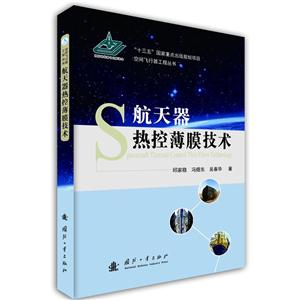航天器热控薄膜技术
本书特色
[
本书介绍了当今航天器热控薄膜技术的发展水平,特别是详细介绍了我国在航天器热控薄膜研究方面的新技术和新产品。
全书共分为7章。第1章概括地介绍了航天器热控薄膜相关的基本知识和物理基础。第2至第5章介绍了航天器常用的热控薄膜材料和器件,主要包括单一结构被动热控薄膜材料、复合结构被动热控薄膜材料、智能型热控薄膜材料和微结构热控薄膜器件的工作原理和应用情况。第6章介绍了航天器常用热控薄膜材料的制备技术、表征方法和性能检测技术。第7章对热控薄膜的常规地面试验、单一空间环境试验和综合辐照试验进行了介绍。
本书内容新颖,实用性强,适合从事热控薄膜技术相关工作的工程技术人员和科研人员使用,亦可供大专院校相关专业的师生阅读。
The book introduces development of spacecraft thermal control thin filmstechnologies nowadays,especially the detail of new technologies and newproducts of thermal control thin films developed in China.
The book consists of 7 chapters.Chapter 1 summarizes fundamental knowledgeand physical basis of spacecraft thermal control thin films.From Chapter 2 toChapter 5,frequently used spacecraft thermal control thin films and devicesare introduced,including principles and applications of passive thermalcontrol thin films with single structure,passive thermal control thin filmswith composite structures,intelligent thermal control thin films andmicrostructure thermal control thin film devices.Chapter 6 introducespreparation,characterization and detection techniques in common use forspacecraft thermal control thin films.Chapter 7 introduces general groundtest,single simulative space environmental test and combined irradiation testfor thermal control thin films.
The content of this book is novel and practical.This book is suitable forengineering technicists and scientific researchers who are engaged in thermalcontrol thin film technology,and can also be read by college teachers andstudents of relative specialty.
]
目录
第1章舰用锅炉的基本结构和工作过程1.1舰用锅炉的分类、用途和要求1.1.1舰用锅炉的分类和用途1.1.2舰用锅炉的要求1.1.3舰用锅炉材料及其要求1.2舰用蒸汽锅炉的基本结构和工作过程1.2.1舰用自然循环蒸汽锅炉1.2.2舰用直流式蒸汽锅炉1.2.3舰用强制循环蒸汽锅炉1.2.4舰用蒸汽锅炉的工作过程1.3舰用蒸汽锅炉的特性第2章燃油及其燃烧产物2.1舰用锅炉用燃油及其特性2.1.1舰用锅炉用燃油2.1.2燃油的物理化学特性2.2燃油燃烧所需的空气量2.2.1可燃元素燃烧所需氧量和产生的产物量2.2.2理论空气量2.2.3实际空气量和空气过余系数2.3燃烧产生的烟气量2.3.1设计热力计算2.3.2烟气分析2.3.3校核热力计算2.4空气和烟气的焓2.4.1空气焓2.4.2烟气焓第3章燃烧原理及燃烧设备3.1燃烧的化学反应动力学基础3.1.1化学反应速度及质量作用定律3.1.2阿累尼乌斯定律及活化能3.1.3影响化学反应速度的主要因素3.1.4链锁反应第1章概论1.1航天器热控与热控薄膜1.2热控薄膜的分类与特点1.2.1热控薄膜的定义1.2.2热控薄膜的特点1.2.3热控薄膜的分类1.3热控薄膜技术相关理论与热控原理1.3.1热控薄膜的热控性能参数1.3.2红外发射率基础理论1.3.3热控薄膜材料的控温原理1.4热控薄膜的空间环境适应性1.4.1热环境对热控薄膜的要求1.4.2电磁辐照环境对热控薄膜的要求1.4.3空间粒子辐照对热控薄膜的要求1.4.4原子氧环境对热控薄膜的要求第2章单一结构被动热控薄膜2.1聚酰亚胺镀锗膜热控薄膜2.1.1基本概念2.1.2研究进展2.1.3发展趋势2.2多层隔热反射屏热控薄膜2.2.1基本概念2.2.2研究进展2.3SiO2热控薄膜2.3.1基本概念2.3.2研究进展2.3.3发展趋势2.4TiAlN热控薄膜2.4.1基本概念2.4.2研究进展2.4.3发展趋势2.5高热导金刚石薄膜2.5.1基本概念2.5.2研究进展2.5.3发展趋势2.6黑色热控薄膜2.6.1基本概念2.6.2研究进展2.6.3发展趋势2.7单一结构热控薄膜的优缺点及适用性第3章复合结构被动热控薄膜3.1玻璃型二次表面镜3.1.1基本概念3.1.2研究进展3.1.3发展趋势3.2柔性二次表面镜3.2.1基本概念3.2.2研究进展3.2.3发展趋势3.3金属-陶瓷(介质)复合热控薄膜3.3.1基本概念3.3.2研究进展3.3.3发展趋势3.4CCAg光学多层复合热控薄膜3.4.1基本概念3.4.2研究进展3.4.3发展趋势3.5复合结构被动热控薄膜的优缺点及适用性第4章智能型热控薄膜4.1二氧化钒智能型热控薄膜4.1.1基本概念4.1.2研究进展4.1.3发展趋势4.2稀土锰氧化物掺杂智能热控薄膜4.2.1稀土锰氧化物掺杂材料基本概念4.2.2研究进展4.2.3发展趋势4.3电致变色热控器件4.3.1基本概念4.3.2研究进展4.3.3发展趋势4.4智能型热控薄膜的优缺点及适用性第5章微结构热控薄膜器件5.1MEMS热控百叶窗5.1.1基本概念5.1.2微型热控百叶窗国内外研究现状5.1.3扭转式微型热控百叶窗结构设计5.1.4扭转式微型热控百叶窗材料选择5.1.5扭转式微型热控百叶窗的机电特性的理论分析5.1.6扭转式微型热控百叶窗有限元仿真模拟5.1.7仿真分析结果与解析计算结果对比5.1.8微型热控百叶窗原理样件研制5.1.9微型热控百叶窗发展趋势5.2微型热开关辐射器5.2.1基本概念5.2.2国内外研究现状5.2.3微型热开关辐射器设计5.2.4微型热开关辐射器驱动电压计算5.2.5仿真分析5.2.6微型热开关辐射器热性能理论分析5.2.7微型热开关辐射器制备5.2.8发展趋势5.3薄膜电加热器5.3.1基本概念5.3.2研究进展第6章热控薄膜制备、表征与检测6.1热控薄膜制备6.1.1真空蒸镀技术6.1.2磁控溅射技术6.1.3微波CVD技术6.1.4溶胶-凝胶法6.1.5原子层沉积技术6.1.6热控薄膜制备方案的选择及关键技术途径6.2热控薄膜表征6.2.1薄膜材料的晶体结构分析6.2.2薄膜材料的微观结构分析6.2.3薄膜材料的化学组成分析6.2.4薄膜材料的光学性能分析6.2.5薄膜材料的电学性能分析6.3热控薄膜检测6.3.1薄膜材料热导率检测技术6.3.2太阳吸收率检测技术6.3.3红外发射率检测技术第7章热控薄膜试验技术7.1地面环境试验7.1.1热控薄膜湿热试验7.1.2热控薄膜附着力试验7.2单一模拟空间环境试验7.2.1真空-紫外辐照试验7.2.2真空-质子辐照试验7.2.3真空-电子辐照试验7.2.4原子氧试验7.2.5热真空试验7.2.6充放电试验7.3综合模拟空间环境试验参考文献CONTENTSChapter 1Introduction1.1Spacecraft thermal control and thermal control thin films1.2Classification and properties of thermal control thin films1.2.1Definition of thermal control thin films1.2.2Properties of thermal control thin films1.2.3Classification of thermal control thin films1.3Theories and principles of thermal control thin film technology1.3.1Thermal control parameters of thermal control thin films1.3.2Theories of infrared emissivity1.3.3Thermal control principles of thermal control thin films1.4Space environmental adaptability of thermal control thin films1.4.1Thermal control requirement for thermal control thin films1.4.2Eletromagnetic radiation protection requirement for thermal control thin films1.4.3Space particle irradiation protection requirement for thermal control thin films1.4.4Atomic oxygen protection requirement for thermal control thin films Chapter 2Passive thermal control thin films with single structure2.1Germanium coated polyimide thermal control thin film2.1.1Basic concept2.1.2Research progress2.1.3Trend in development2.2Multilayer heat insulation reflective plate thermal control thin film2.2.1Basic concept2.2.2Research progress2.3Silicon dioxide thermal control thin film2.3.1Basic concept2.3.2Research progress2.3.3Trend in development2.4TiAlN thermal control thin film2.4.1Basic concept2.4.2Research progress2.4.3Trend in development2.5High heat conductivity diamond thermal control thin film2.5.1Basic concept2.5.2Research progress2.5.3Trend in development2.6High absorptivity thermal control thin film2.6.1Basic concept2.6.2Research progress2.6.3Trend in development2.7Properties and applicability of passive thermal control thin filmswith single structureChapter 3Passive thermal control thin films with composite structures3.1Glass second surface mirror3.1.1Basic concept3.1.2Research progress3.1.3Trend in development3.2Flexible second surface mirror3.2.1Basic concept3.2.2Research progress3.2.3Trend in development3.3Metal-ceramic(dielectric) composite thermal control thin film3.3.1Basic concept3.3.2Research progress3.3.3Trend in development3.4CCAg optical multilayer composite thermal control thin film3.4.1Basic concept3.4.2Research progress3.4.3Trend in development3.5Properties and applicability of passive thermal control thin filmswith composite structuresChapter 4Intelligent thermal control thin films4.1Vanadium dioxide intelligent thermal control thin film4.1.1Basic concept4.1.2Research progress4.1.3Trend in development4.2Rare earth manganese oxide doped intelligent thermal control thin film4.2.1Basic concept of rare earth manganese oxide doped materials4.2.2Research progress4.2.3Trend in development4.3Electrochromic thermal control device4.3.1Basic concept4.3.2Research progress4.3.3Trend in development4.4Properties and applicability of intelligent thermal control thin filmsChapter 5Microstructure thermal control thin film devices5.1MEMS thermal control louvers5.1.1Basic concept5.1.2Research status of MEMS thermal control louvers at home and abroad5.1.3Configuration design of torsion type MEMS thermal control louvers5.1.4Material selection of torsion type MEMS thermal control louvers5.1.5Theoretical analysis of electromechanical characteristics for torsion type MEMS thermal control louvers5.1.6Finite element simulation of torsion type MEMS thermal control louvers5.1.7Comparison of finite element simulation and analytic calculation5.1.8Principled sample preparation of MEMS thermal control louvers 5.1.9Trend in development of MEMS thermal control louvers5.2Minitype thermal switch radiator5.2.1Basic concept5.2.2Research status at home and abroad 5.2.3Design of minitype thermal switch radiator5.2.4Drive voltage calculation of minitype thermal switch radiator5.2.5Simulation of minitype thermal switch radiator 5.2.6Theoretical analysis of heat characteristics for minitype thermal switch radiator5.2.7Preparation of minitype thermal switch radiator 5.2.8Trend in development5.3Thin film electric heater5.3.1Basic concept5.3.2Research progressChapter 6Preparation, characterization and detection of thermal control thin films6.1Preparation of thermal control thin films6.1.1Vacuum evaporation6.1.2Magnetron sputtering6.1.3Microwave CVD6.1.4Sol-Gel6.1.5Atomic layer deposition6.1.6Preparation method selection and key technology of thermal control films6.2Characterization of thermal control thin films6.2.1Crystal structure analysis of thin films6.2.2Microstructure analysis of thin films6.2.3Chemical composition analysis of thin films6.2.4Optical performance analysis of thin films6.2.5Electrical performance analysis of thin films6.3Detection of thermal control thin films6.3.1Thermal conductivity detection of thin films6.3.2Solar absorption detection of thin films6.3.3Infrared emissivity detection of thin filmsChapter 7Test technique for thermal control thin films7.1Ground environmental test7.1.1Damp heat test of thermal control thin films7.1.2Adhesion test of thermal control thin films7.2Simulative individual space environmental test7.2.1Vacuum-ultraviolet irradiation test7.2.2Vacuum-proton irradiation test7.2.3Vacuum-electron irradiation test7.2.4Atomic oxygen test7.2.5Thermal vacuum test7.2.6Charge-discharge test7.3Combined irradiation testReference
封面

书名:航天器热控薄膜技术
作者:邱家稳
页数:未知
定价:¥89.0
出版社:国防工业出版社
出版日期:2016-06-01
ISBN:9787118105766
PDF电子书大小:86MB 高清扫描完整版
